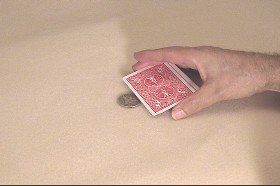| carried to the upper left position where again another card is slid off the top of the stack |
| and placed at that position. Just as the left hand grasps a card to put to the table, the |
| coin under the stack is allowed to fall to the table. Then the last card is placed at the |
| Schneider European Transfer |
| I have always thought the European Transfer was quite intelligent. However, I have |
| always have had trouble with the somewhat odd position of the hand while holding the |
| cards. In the simple modification presented here, the position of the hand like a more |
| normal grip. In this grip, the cards are held by the short edges. The second finger |
| presses against the short edge of the packet of four while the thumb presses in the |
opposite direction against the other short end of the packet.  Held like this the Held like this the |
| third finger remains unseen under the packet and is available to pick up coins as the left |
| first finger slides a card of the top of the stack. Here is a sample showing how a coin |
| might be picked up without the audience being aware of it. Hold four cards as |
| described above. Move the cards over a coin as you prepare to slide a card on top of |
the coin. The first finger of the left hand touches the top card.  The third finger The third finger |
| presses against the edge of the coin while the tip of the thumb is pressed against the |
| other edge of the coin. The cards are moved to the right. The left fingerís pressure |
|
|   |

